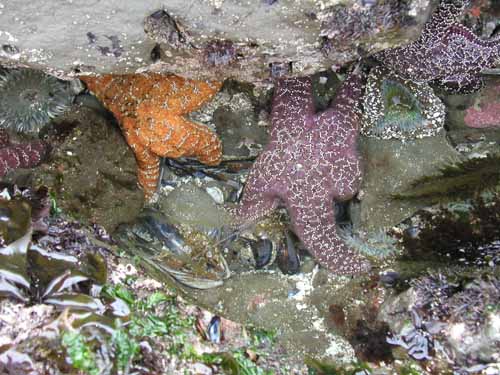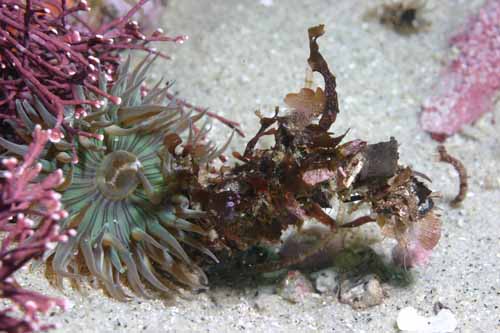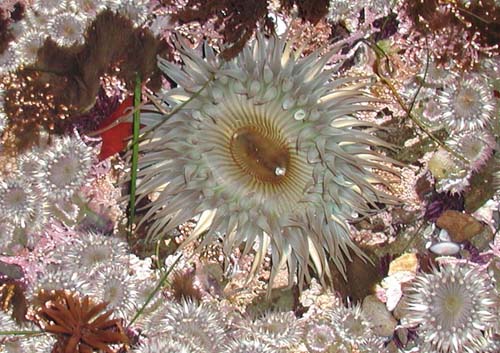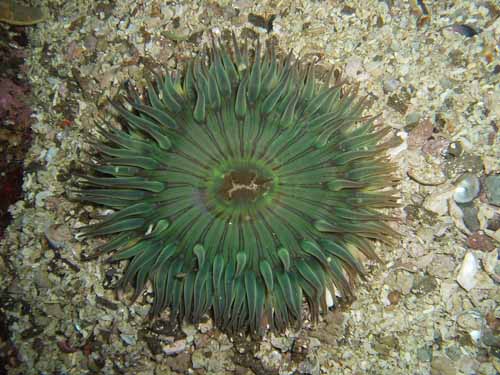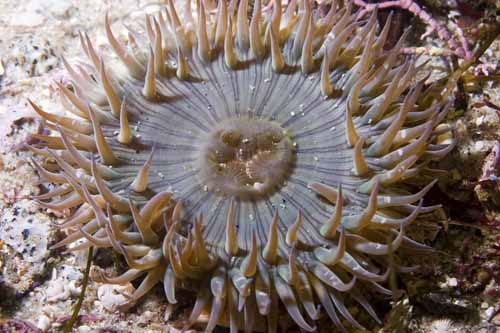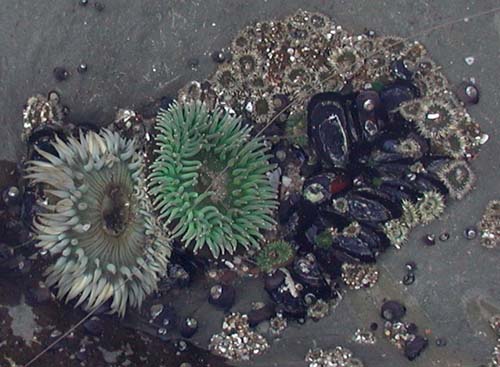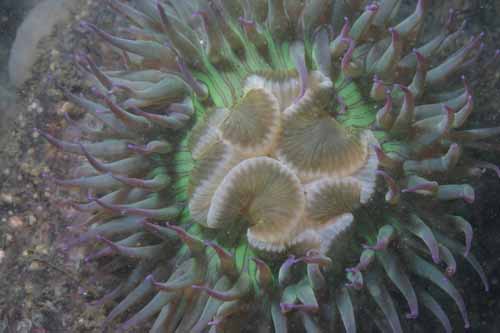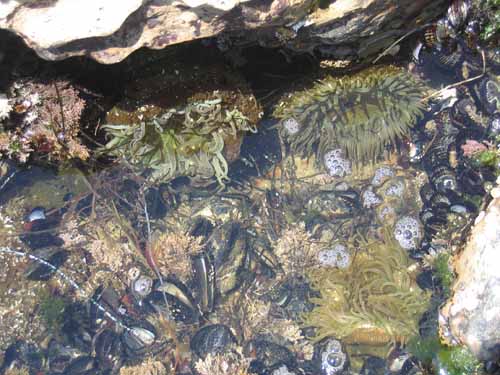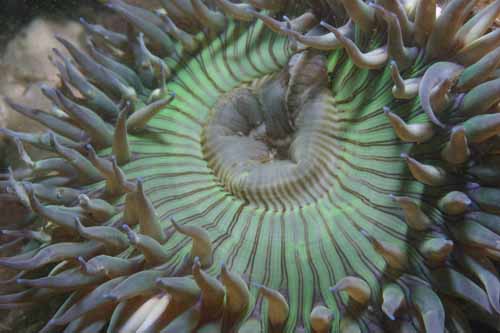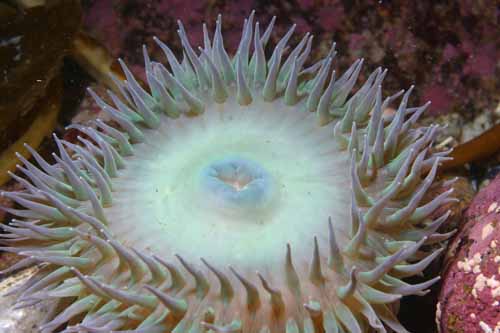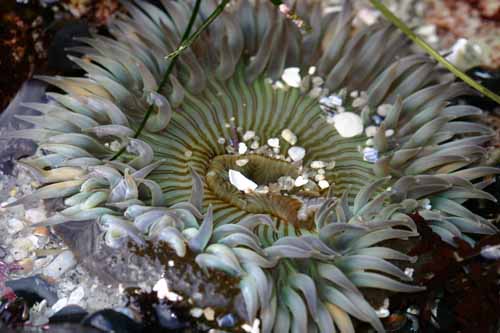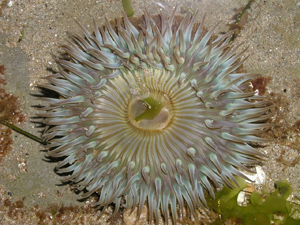
Sunburst anemone
Anthopleura sola
Overview
Key Features:
The radiating lines on the oral disc, large size (up to 15 cm in diameter), and isolation from other anemones separate this species from congeners.
Similar Species:
Giant green anemone (Anthopleura xanthogrammica)Aggregating anemone (Anthopleura elegantissima)
Primary Common Name:
Sunburst anemoneGeneral Grouping:
Corals and anemonesGeographic Range:
Bodega Bay, California to central Baja California
This anemone inhabits the mid to low intertidal and shallow subtidal zones of the eastern Pacific Ocean, ranging from Bodega, California to Baja California.
Intertidal Height:
-2 to 0 feet (-0.6096 to 0 meters)Notes:
Sunburst anemones are found in tide pools and channels.
Subtidal Depth Range:
Minimum Depth: 0 meters or 0 feetMaximum Depth: 18 meters or feet
Notes:
In the subtidal, they occur in kelp forests, usually near the base of reefs and at depths <20 m.
Habitats:
bay (rocky shore), exposed rocky shore, kelp forest, protected rocky shoreNotes:
On exposed coastlines, bays and harbors, on seawalls, rocks, tidepools, and pilings; from the low tide line to at least 15 m deep. This species is solitary, but other conspecifics or congeners may be within <10 cm. The basal disc is elongate and tends to be inserted into cracks and holes in the rocky substratum.
Abundance:
Relative Abundance:
Common
Species Description:
General:
The Sunburst anemone, Anthopleura sola, is cylindrical and greenish-brown, and the coloring can be either drab or vibrant. The oral disk is green or bluish-green, and has paired radiating lines leading to the bases of the tentacles. The column has wart-like protuberances (called verrucae), generally aligned in vertical columns, and is usually covered with shell debris. Numerous thick, short, tapered tentacles surround the oral disk. The tentacles are similar in color to the column, and in some cases flecked with white patches and with a slight purple hue towards the tips. This species adheres firmly to rocks and pilings with its pedal disc, but is capable of movement. When contracted, the anemone forms a hemi-spherical mound.
Distinctive Features:
The Sunburst anemone, Anthopleura sola, is distinguished from other anemones by its large size, solitary nature, and the distinctive radiating lines on the oral disc. Like all cnidarians, it has stinging cells called cnidocytes located within the tentacles. These cells eject barbs that penetrate into the tissue of prey and inject a neurotoxin, but are the barbs are too short to penetrate into relatively thick human skin. To reduce desiccation during low tides, the anemone retracts its tentacles and closes, leaving only a green hemisphere with bits of shell debris attached to the column.
Size:
Column diameter: up to 15 cm (6.7 in.)
Base: up to 20 cm
Height: up to 30 cm (11.8 in.)
Tentacular crown diameter: up to 25 cm (9.8 in.)
Natural History:
General:
Anthopleura sola that live in direct sunlight are often a more vibrant green, while sheltered specimens are paler. Dr. John Pearse wrote that "Zoochlorellae have not be found in sunburst anemones. Indeed, zoochlorellae have not been found in any of the species of Anthopleura south of Bodega, CA. Zooxanthellae are golden brown and do not give these anemones their green color at all. The vibrant green (or fluorescent green) sometimes seen in sunburst anemones is probably due to a modification of the carotinoid-protein that gives the anemones their greenish brown color."
Although other species of Anthopleura can reproduce asexually via binary fission, the sunburst anemone is not know to do so. In sexual reproduction, both eggs and sperm are released into the water column, and after fertilization, the new individual settles to form a new polyp. There is no free-swimming medusa stage, as found in the jellies (scyphozoans) and many hydroids (hydrozoans).
The hermit crab Pagarus samuelis often walks up and down the column of the anemone, even walking through and stroking the tentacles and probing the mouth opening, all without being stung. It is possible that the hermit crab becomes so coated with mucus from the anemone that the anemone responds as if the crab were its own tissue.
For many years, Anthopleura sola was considered a larger, solitary version of the smaller, aggregating anemone Anthopleura elegantissima. However, Dr. Vicki Pearse and Dr. Lisbeth Francis formally described the sunburst anemone as a separate species in 2000 (Proceedings of the Biological Society of Washington, 133(3):596-608). One specimen kept at Long Marine Laboratory at UC Santa Cruz was there for many years. If the incoming water flow was altered, the large anemone would change its posisiton in the tank to optimize the current flow, since this is a suspension feeder (sedentary, not sessile).
Predator(s):
Predators may include the nudibranch Aeolidia papillosa, and the snail Epitonium tinctum, which can feed on tentacles. The snails Opalia chacei and O. funiculate, and the sea spider Pycnogonum sternsi, feed on the column of Anthopleura xanthogrammica, and may also prey upon A. sola.
Prey:
The diet of A. sola consists mainly of snails, mussels, small sea urchins and fishes, detritus, and organic flotsam and jetsam.
Feeding Behavior:
Photosynthetic, Sessile suspension feederNotes:
Prey are subdued and captured after coming into contact with the anemones stinging tentacles. Once the prey has been secured, it is pulled into the mouth, located in the center of the oral disc. When digestion is finished, it excretes the waste through the same opening. It also received nutrients from symbiotic algae found in the cells.
Seasonal Behavior
February - July
Reproduction:
The similar species, Anthopleura elegantissima, has ova present as early as February through July (in individuals observed in Morro Bay).Issues
Listing Status:
Not known.References
- Carlton, J.T. 2007.
The Light and Smith Manual, 4th edition
Intertidal Invertebrates from Central California to Oregon
University of California Press. 1001 p.
- Pearse, V. and L. Francis. 2000. Anthopleura sola, a new species, solitary sibling species to the aggregating anemone, A. elegantissima (Cnidaria: Anthozoa: Actinaria: Actiniidae). Proceedings of the Biological Society of Washington 113(3):596-608.
Related Information
Photo Library
Click on an image below to view a larger version in the SIMoN Photo Library. You will also be able to view important information on each photo such as photographer, date, caption and more
